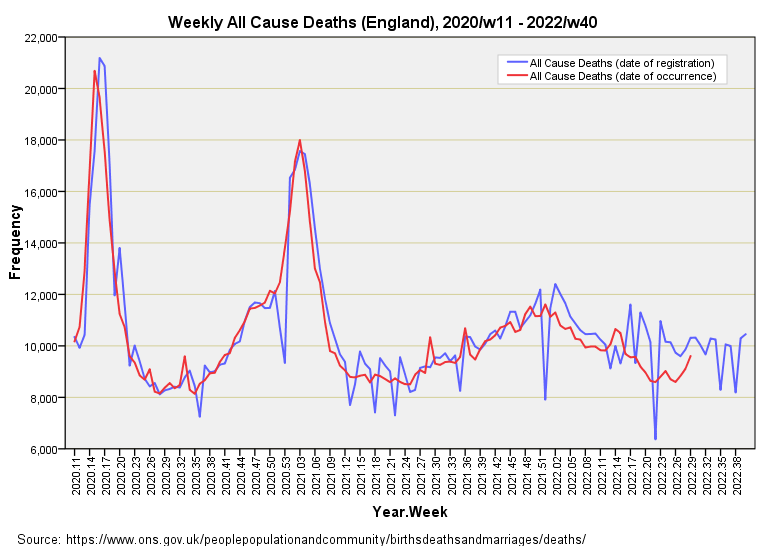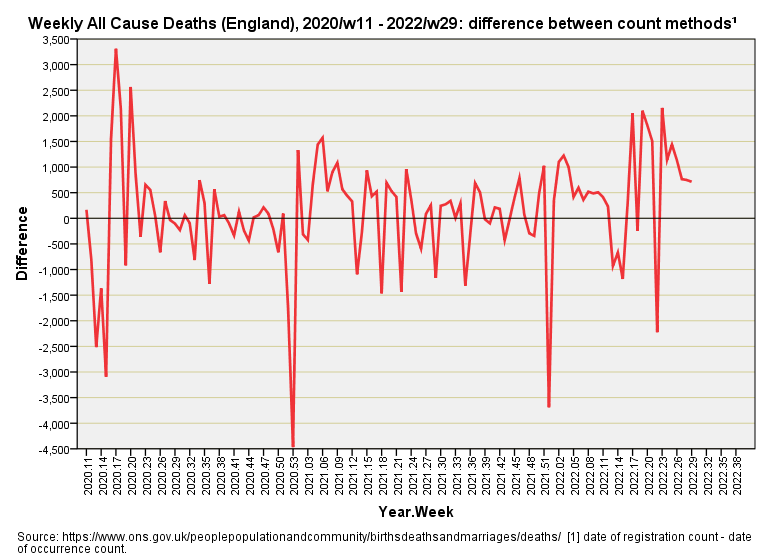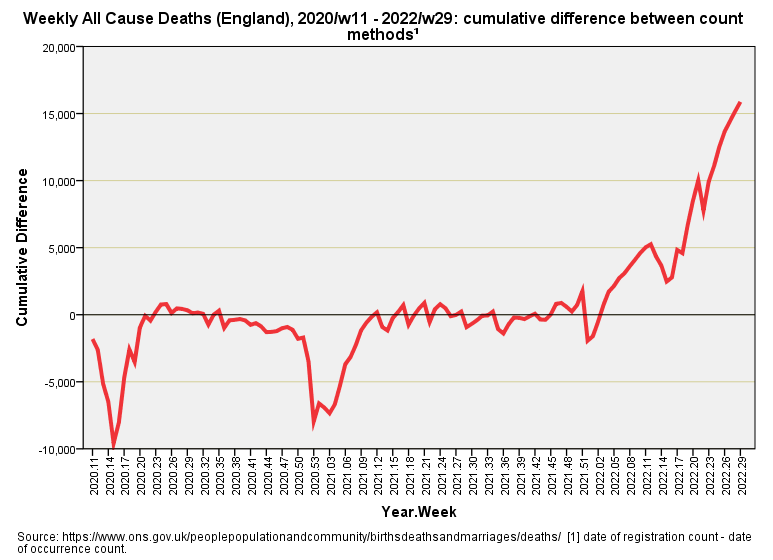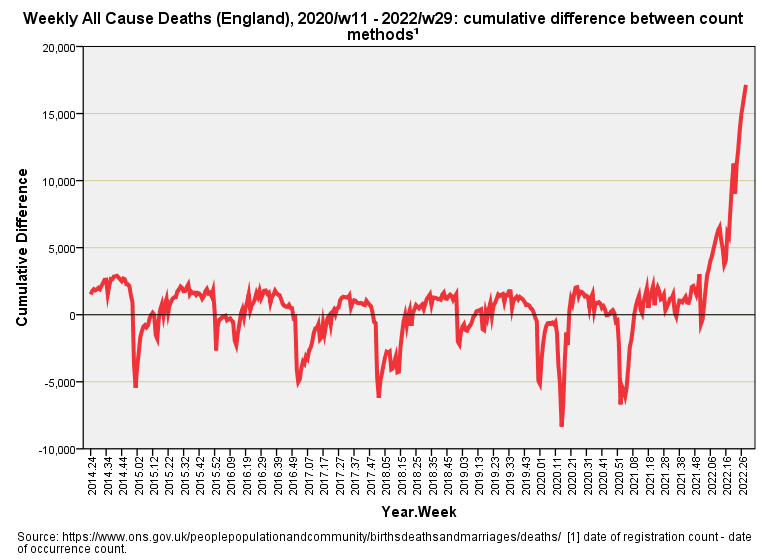Counting Deaths (Part 2)
A comparison of official counts all cause deaths by date of registration (England) with counts by date of occurrence
In part 1 of this series we compared weekly counts of all cause deaths for England by registration date with weekly counts by actual date of death for the pre-pandemic period of 2014/w1 - 2020/w10. Discrepancies arising from delays to processing during holiday periods were noted and quantified, and we noted lack of any underlying trend toward more or less efficient processing over a five year period. We now need to repeat the analysis for the post-pandemic period so get the grill on, throw some bread under and grab the butter…
The Post-Pandemic Era
Herewith the critical slide…
Right at the very beginning we see the registered death count fall below the actual death count because of reporting and processing delays, but these counts soon catch up to overshoot during 2020/w16 and 2020/w17. It is worth noting that during week 16 (the pandemic peak) the ONS reported 21,182 registered deaths for England whereas the actual count was 19,641, this representing an overshoot of 1,541 deaths (7.8%).
We observe another significant overshoot during week 20, when the registered tally reached 18,801, this figure being some 2,564 more deaths than the 11,237 that actually occurred during that week (22.8%). It will be interesting to look back and see what press statements were issued during both of these artificial peaks.
We may note a holiday dip during week 36 and again during week 53 that appear to be caught up over the period 2021/w4 – 2021/w12. This is a rather prolonged period to sort administrative matters and one wonders what was going on behind the scenes. There’s a rather curious yo-yo effect for registered deaths over the period 2021/w12 – 2021/w24 and we may add this to our list of ponderables.
The lull in registration during 2021/w52 generates another artificial peak of 12,399 deaths during 2022/w2, this being some 1,102 more deaths than the 11,297 that actually occurred (9.8%). From 2022/w18 onwards the slide flips into wacko mode, and we see counts by registration date soar above counts by occurrence date. Some folk may leap to the conclusion that the ONS were making things up but this is not the case - system limits mean real time counts are not possible (hence use of the word ‘provisional’ in ONS weekly outputs).
We need to remember that the datafile that generates the red curve was published on 26 August 2022 (week 35), whereas the datafile that generates the blue curve was published on 18 October 2022 when data capture was more complete. The odd thing here, however, is that my eyeballs suggest registration and subsequent processing of deaths fell several weeks behind. This merits further investigation.
Vive La Différence!
Variations brought about by administrative delays are easier to clock in this next slide of differences in the weekly count:
We can now see a rather strange situation right at the very beginning of the pandemic, when published figures for registered all cause deaths fall into a negative count exceeding -3,000 deaths. This inability to rapidly process data resulted in a magnificent overshoot hitting +3,310 deaths during 2020/w17.
I spotted a similar pattern back in October 2020 when I compared announced (published) weekly totals for COVID deaths with actual weekly totals, the difference in the two reporting streams generating artificially elevated figures. Summary stats-wise this difference series hit a minimum of -4,467 deaths during 2020/w53, and a maximum of 3,310 deaths during 2020/w17, with the median and mean fetching up at 249.50 and 143.96 respectively.
Being Sneaky
A sneaky thing we can do at this point is plot out the cumulative difference. This is a handy series to eyeball because failure to register/process deaths for any reason will be followed by a period of catch-up, this resulting in a zero net cumulative balance. What we should see is a time series that bobs about the zero value on the y-axis that dips into negative and then recovers back to zero. This is pretty much what we see but not quite:
Incredible as it may seem the cumulative negative excess reaches down to -9,591 during 2020/w15, which means the ONS were happy to sit on the processing of deaths to the tune of 10k during the first wave; either that or next of kin/service providers were falling behind in registration. A similar situation appears during the third wave when the cumulative negative excess reaches down to -7,944.
The upward tail from 2022/w2 onward arises from incomplete data capture as stated. What is worth noting is just how long this tail is, stretching as it does from 2022/w2 to 2022/w29. Now that is some tail and indicates the ONS were running no less than 27 weeks behind in processing certificates back in August. The big question for me is how many more deaths are going to appear in the data record that have already occurred: I suspect we have not seen the full extent of the problem.
Hold The Front Page
At this point folk might be growling at the ONS et al, so there’s one thing I need to check to allay suspicion and that is to plot out the cumulative excess for the period 2012/w24 – 2022/w29 to give us some historical perspective. To do this I first have to make a small adjustment to eliminate any bias introduced by using part year periods, this giving the whole year series for 2015 – 2019 the desirable mean value of zero. Herewith the result:
Now that is rather pleasing and rather informative! We now see that significant negative values have been reached historically, so the ONS has likely not been gaming the data. Back during 2018/w1 the cumulative difference bottomed out at -7,448 deaths compared to the -9,951 deaths of 2020/w15, suggesting a pandemic-driven slide of 2,143 deaths at most, and this during the most extraordinary time of upheaval. I am going to suggest that there’s nothing to see here other than a system subject to truly exceptional circumstances. What should concern us are those missing deaths for 2022 - how many more are yet to get processed?
Kettle On!






I can see that the date of occurrence is factual and cannot be manipulated except by fraud. But isn’t this also true of date of registration? The next of kin rocks up at the local registry, usually within 5 days and reports the death. Isn’t that the date of registration? Maybe there’s a third date which is the date of entry into the ONS’s systems. I can see how that can be manipulated.